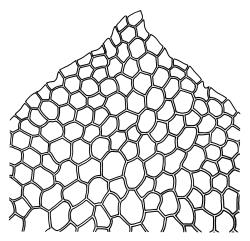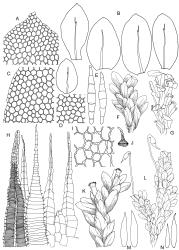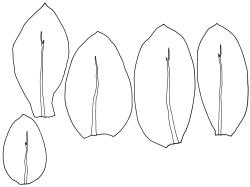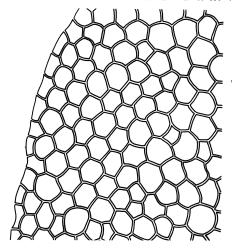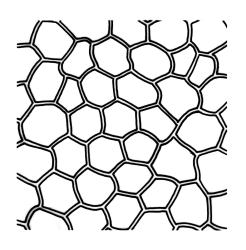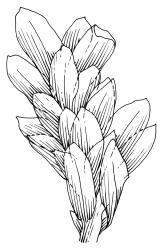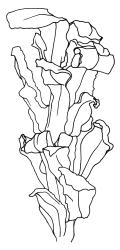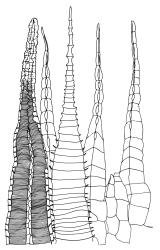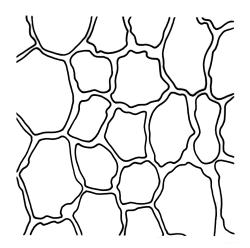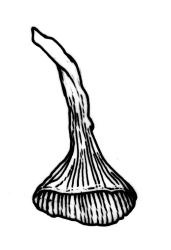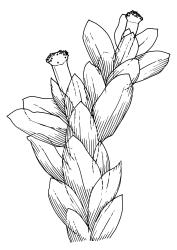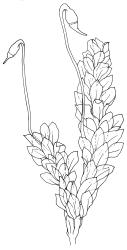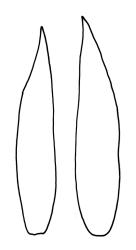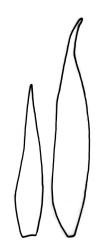- ≡ Pterygophyllum distichophylloides Broth. & Dixon in Dixon, Bull. Torrey Bot. Club 42: 106 (1915)
- = Pterygophyllum colensoi Broth. ex Dixon, Bull. New Zealand Inst. 3: 290 (1927) nom. nud.
Plants medium-sized, oily yellow-green when fresh, unchanged or dark green when dry. Stems prostrate, sparsely to moderately branched, pale brown to yellow, to 45 mm, in cross-section with a distinct central strand, 2–4 cortical cell layers with moderately thickened walls, and lacking a hyaloderm, densely beset below with pale brown, nearly smooth, and much-branched rhizoids. Shoots c. 3 mm wide, complanate, often ending in naked, 2–3 mm long pseudopodia and terminated by a cluster of fusiform gemmae. Leaves inserted in 6 (or 8?) ranks, strongly crisped when dry, erect-spreading, imbricate, and complanate when moist, not or weakly asymmetric, those in dorsal and ventral ranks scarcely differentiated from those in lateral ranks, broadly elliptic to ± spathulate, tapered to broadly acute, rounded, or sometimes weakly apiculate apices, plane, not concave, unbordered, entire, (1.0–)1.3–2.5(–2.8) × 0.5–1.3 mm; upper laminal cells smooth, thin-walled (c. 2 μm at thinnest point), weakly to moderately collenchymatous, hexagonal-isodiametric, 24–42 μm diam., gradually becoming ± oblong and non-collenchymatous towards base; marginal cells and alar cells not differentiated. Costa single, rather weakly defined, c. 35–-60 μm wide at mid leaf, dilated in lowest ⅓ or more, unbranched or with a short distal spur, ½ to ¾ or more the length of the leaf, in cross-section biconvex and lacking stereids. Pseudoparaphyllia foliose, lanceolate, c. 300–400 μm long. Gemmae borne in a terminal cluster at the apex of a pseudopodium, narrowly fusiform, 160–240 μm long, with 5–9 transverse septa.
Dioicous. Perichaetial leaves ovate-lanceolate, ecostate, c. 1.2 mm. Perigonia not seen. Setae lateral, 7–11 mm, erect, smooth, red, twisted weakly to the left; capsules pendent, symmetric, ovoid from a short, tuberculate neck, 1.0–1.5 mm, weakly constricted below the mouth, smooth when dry, red-brown; exothecial cells oblong to isodiametric, firm-walled, rather weakly thickened at corners, 12–18 μm in greater diam. Annulus well-developed, falling with the operculum. Operculum long-rostrate from a conic base, c. 0.8 mm long. Exostome teeth yellow-brown, c. 400 μm long, lanceolate with a rather distinct shoulder, bordered, scarcely furrowed (the gap between portions of the tooth <6 μm wide, extending < ⅔ the length of the tooth, and not visible with stereoscope), finely cross-striate below and baculate above on outer surface, with lamellae on inner surface that project laterally as very weak marginal trabeculae; endostome pale yellow, with basal membrane 100–120 μm high, segments c. 260 μm, nearly equalling the teeth, keeled and weakly perforate, papillose, cilia absent. Calyptra mitrate, smooth, lobed at base. Spores (10–)12–15 μm, green, finely papillose.
NI: N Auckland (Maungataniwha Range, Titirangi), S Auckland (Kaimai Range), Gisborne (Marumaru Caves), Hawke’s Bay (Waitai Valley near Wairoa, Mohi Bush Scenic Reserve, Waipātiki, Herbertville), Wellington (Pohangina Valley); SI: Nelson (widespread), Marlborough (D’Urville I.),Westland (Punakaikī River, Rapahoe Range, Point Elizabeth); Ch. This uncommon species is also recorded (as Pterygophyllum distichophylloides) from a c. 60 m deep, hypermoist limestone chasm at the Mangapū Cave System near Waitomo, S Auckland L.D. by de Lange & Stockley (1987), but this material has not been confirmed.
Endemic.
On moist and often deeply shaded rock (usually limestone), less commonly on calcareous clay or marl and often associated with stream margins or beds of intermittent watercourses. Tolerant of highly reduced light conditions. Several collections have been seen from dolines. One collection from the Ōpārara River Valley (Nelson L.D.) grew atop a well-rotted log, an unusual substrate. Achrophyllum dentatum and Distichophyllum microcarpum are frequent associates. Ranging from c. 80–300 m on the North I. and from near sea level (several localities including Fox River, Nelson L.D.) to at least 200 m (Ōpārara River, Nelson L.D.) on the South I. Sporophytes are rare.
Beeveria distichophylloides was originally described in Pterygophyllum by Dixon (1915). Two New Zealand species of Pterygophyllum sensu Broth. were transferred to the newly described Achrophyllum by Vitt & Crosby (1972), who excluded, without elaboration, the present species. Although Pterygophyllum colensoi is included as a nom. nud. in synonymy by Fife (1992), a more considered reading of Dixon (1927) suggests that he merely acknowledged Brotherus’ earlier herbarium annotation of W. Colenso 3115 (BM 1109229!).
Both sporophytic and gametophytic features preclude placement of the present species in Achrophyllum. The exostome teeth have only a very weak furrow (<6 μm wide near its base and not visible under the stereoscope). The teeth are short (c. 400 μm), with short (6–9 µm) marginal trabeculae in their lower portions, and the endostome segments are perforate. In A. quadrifarium (the generitype of Achrophyllum) the exostome teeth have a strongly developed furrow 30–36 μm wide near its base and clearly visible under the stereoscope. Its teeth are more than 700 μm long, with long (18–24 μm) marginal trabeculae below, and its endostome segments lack perforations.
The morphology of the gemmae provide further distinction. In B. distichophylloides the gemmae are unbranched, narrowly fusiform, transversely septate, and borne in terminal clusters atop a leafless pseudopodium that is reminiscent of the pseudopodia in Aulacomnium. In Achrophyllum the gemmae are L- or T-shaped, septate, and borne on intra-marginal cells of vegetative leaves.
At Ōpārara River "luminescent" plants of B. distichophylloides have been observed, suggestive of Schistostega pennata or Mittenia plumula protonema, although the reflective glow may have been in part due to moisture droplets on the plants. Closely associated plants of A. dentatum did not appear luminescent at this site.
The habitat and presence of gemmae-bearing pseudopodia are probably sufficient for recognition of this plant, but the latter are often absent or difficult to observe. Confusion seems most likely with the more common Achrophyllum quadrifarium, but B. distichophylloides is generally a much smaller plant with more elliptic or spathulate leaves and much smaller laminal cells (not visible under the hand-lens). Confusion could also occur with Distichophyllum microcarpum, but that is generally a much larger plant, forming distinctive layered mats and having a group of conspicuously enlarged juxtacostal laminal cells. Confusion of B. distichophylloides with Distichophyllum pulchellum seems less likely, despite their similar coloration when fresh.



